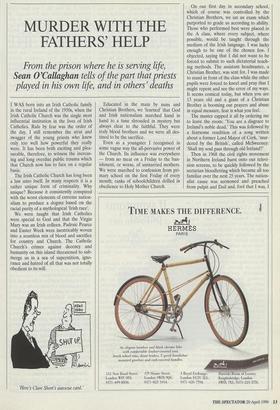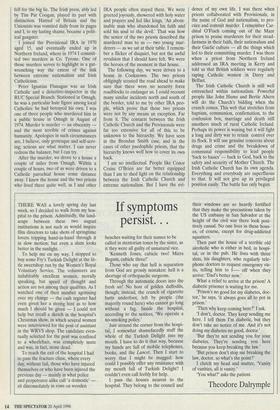MURDER WITH THE FATHERS' HELP
From the prison where he is serving life,
Sean O'Callaghan tells of the part that priests
played in his own life, and in others' deaths
I WAS born into an Irish Catholic family in the rural Ireland of the 1950s, when the Irish Catholic Church was the single most influential institution in the lives of Irish Catholics. Rule by fear was the order of the day. I still remember the strut and swagger of the young priests who knew only too well how powerful they really were. It has been both exciting and plea- surable, therefore, to witness the increas- ing and long overdue public trauma which that Church now has to face on a regular basis.
The Irish Catholic Church has long been a law unto itself. In many respects it is a rather unique form of criminality. Why unique? Because it consistently conspired with the worst elements of extreme nation- alism to produce a dogma based on the racial purity of a mythological 'Irish race'.
We were taught that Irish Catholics were special to God and that the Virgin Mary was an Irish colleen. Padraic Pearce and Easter Week were inextricably woven into a seamless mix of blood and sacrifice for country and Church. The Catholic Church's crimes against decency and humanity on this island threatened to sub- merge us in a sea of superstition, igno- rance and hatred of all that was not totally obedient to its will.
Here's Clare Short's autocue card.' Educated in the main by nuns and Christian Brothers, we 'learned' that God and Irish nationalism marched hand in hand to a tune shrouded in mystery but always clear to the faithful. They were truly blood brothers and we were all des- tined to be the sacrifice.
Even as a youngster I recognised in some vague way the all-pervasive power of the Church. Its influence was everywhere — from no meat on a Friday to the ban- ishment, or worse, of unmarried mothers. We were marched to confession from pri- mary school on the first Friday of every month; ranks of schoolchildren drilled in obedience to Holy Mother Church. On our first day in secondary school, which of course was controlled by the Christian Brothers, we sat an exam which purported to grade us according to ability. Those who performed best were placed in the A class, where every subject, where possible, would be taught through the medium of the Irish language. I was lucky enough to be one of the chosen few. I objected, saying that I did not want to be forced to submit to such dictatorial teach- ing methods. The assistant headmaster, a Christian Brother, was sent for. I was made to stand in front of the class while the other pupils were forced to kneel and pray that I might repent and see the error of my ways. It seems comical today, but when you are 13 years old and a giant of a Christian Brother is booming out prayers and abuse in equal measure, fear is what you feel.
The master capped it all by ordering me to leave the room: 'You are a disgrace to Ireland's noble dead.' This was followed by a fearsome rendition of a song written about a former Lord Mayor of Cork, 'mur- dered by the British', called McSweeney: `Shall my soul pass through old Ireland?'
Then in 1968 the civil rights movement in Northern Ireland burst onto our televi- sion screens, to be quickly followed by the sectarian bloodletting which became all too familiar over the next 25 years. The nation- alist cause was sermoned and preached from pulpit and Dail and, fool that I was, I fell for the big lie. The Irish press, ably led by Tim Pat Coogan, played its part with distinction. Hatred of Britain and the Unionists was vomited daily from its pages and I, to my lasting shame, became a polit- ical gangster.
I joined the Provisional IRA in 1970 aged 15, and eventually ended up in Northern Ireland, where in 1974 I commit- ted two murders in Co. Tyrone. One of those murders serves to highlight in a gut- wrenching way the extent of the link between extreme nationalism and Irish Catholicism.
Peter Ignatius Flanagan was an Irish Catholic and a detective-inspector in the RUC Special Branch. Stationed in Omagh, he was a particular hate figure among local Catholics: he had betrayed his own. I was one of three people who murdered him in a public house in Omagh in August of 1974. Murder is murder — an obscenity and the most terrible of crimes against humanity. Apologies in such circumstances are, I believe, only grotesque and self-serv- ing; actions are what matter. I can never redress the balance, but I can try.
After the murder, we drove to a house a couple of miles from Omagh. Within a couple of hours, two of us were driven to a Catholic parochial house some distance away. I knew the house and the two priests who lived there quite well, as I and other IRA people often stayed there. We were greeted joyously, showered with holy water and prayers and fed like kings. 'An abom- inable man who abandoned his faith and sold his soul to the devil.' That was how the senior of the two priests described the murdered man to us — two young mur- derers — as we sat at their table. I remem- ber a flicker of disquiet, but not the awful revulsion that I should have felt. We were the heroes of the moment in that house.
The following day, we were driven to a house in Cookstown. The two priests obligingly scouted the road ahead to make sure that there were no security force roadblocks to endanger us. I could recount many similar incidents north and south of the border, told to me by other IRA peo- ple, which prove that those two priests were not by any means an exception. Far from it. The contacts between the Irish Catholic Church and the Provisionals were far too extensive for all of this to be unknown to the hierarchy. We have seen in the Brendan Smith case, and in the cases of other paedophile priests, that the hierarchy knows well how to cover its own back.
I am no intellectual. People like Conor Cruise O'Brien are far better equipped than I am to shed light on the relationship between the Irish Catholic Church and extreme nationalism. But I have the evi- dence of my own life. I was there when priests collaborated with Provisionals, in the name of God and nationalism, to pro- cure and commit murder. I remember Car- dinal O'Fiach coming out of the Maze prison to praise murderers for their stead- fastness in their faith, their nationalism and their Gaelic culture — all the things which led to their committing murder. I was there when a priest from Northern Ireland addressed an IRA meeting in Kerry and told us that British soldiers were regularly raping Catholic women in Derry and Belfast.
The Irish Catholic Church is still well entrenched within nationalism. Powerful people like John Hume and Bertie Ahern will do the Church's bidding when the crunch comes. This web that stretches from baptism, communion, confirmation, to the confession box, marriage and death still smothers much of rural Catholic Ireland. Perhaps its power is waning but it will fight a long and dirty war to retain control over its flock. It will use genuine concerns about drugs and crime and the breakdown of communal responsibility to lead people `back to basics' — back to God, back to the safety and security of Mother Church. The Irish Catholic Church has its own agenda. Everything and everybody are superfluous to that. It will not give up its privileged position easily. The battle has only begun.



































































 Previous page
Previous page